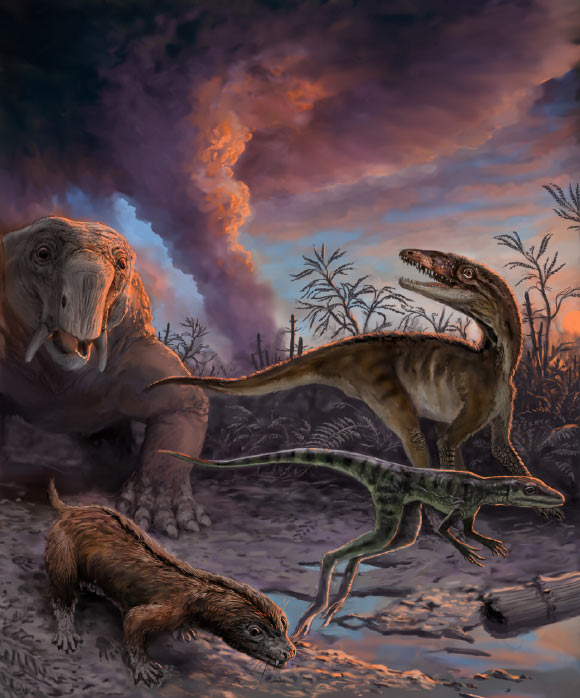A multinational group of paleontologists has determined that the time elapsed between the emergence of early dinosauromorphs (dinosaur relatives) and the origin of the first dinos is 5 – 10 million years shorter than previously thought.

Triassic creatures escaping from an erupting volcano 235 million years ago in northwestern Argentina. These species, found as fossils in the Chañares Formation, include early mammal relatives – (the dicynodont Dinodontosaurus in the left background, and the cynodont Massetognathus in the left foreground) and early dinosaur relatives (Lewisuchus in the right background, and Lagerpeton in the right foreground). Image credit: Victor Leshyk.
The group, led by University of Utah paleontologist Dr Randall Irmis, applied radioactive isotope measurements to date zircon crystals found in the sediments of the Argentinian Chañares Formation.
The paleontologists found that the formation, and therefore the fossils of early dinosauromorphs found in it, is 234 to 236 million years old (Triassic period) – 5 to 10 million years younger than previous estimate.
“To discover that these early dinosaur relatives were geologically much younger than previously thought was totally unexpected,” said Dr Irmis, who is a co-author of a paper in the Proceedings of the National Academy of Sciences.
He and his colleagues collected two rock samples from the formation – one from the base of the level where fossils were preserved and one from near the formation’s top.
“The Chañares Formation contains tuffs, or volcanic ashes, that can be dated with great accuracy,” said study lead author Dr Claudia Marsicano, of the University of Buenos Aires, Argentina.
“So in this basin, not only are there many high-quality, complete fossils that allow us to easily identify taxa, but there are also tuffs in between that allow us to date the entire column.”
The rock samples include volcanic ash that erupted from volcanoes at the same time the sediments were deposited. The samples were then crushed to extract zircon crystals from this ash.
When these crystals formed during the Triassic Period, they only incorporated uranium; over time, some of this uranium decayed into lead at an exact known rate.
By measuring the uranium/lead ratio in each zircon crystal with a mass spectrometer, the team was able to determine the precise date age the crystals formed.
The radioisotopic dating demonstrated that the base formation sample is no older than 236 million years old and the top layer is no older than 235 million years old, with a possibility of being as young as 234 million years old.
This demonstrates that the time elapsed between the appearance of early dinosaur relatives and the origin of dinosaurs is much shorter than previously thought.
The results also call the timelines of a wide variety of other fossil-bearing formations across the world, all believed to be from the Middle Triassic Period, into question.
_____
Claudia A. Marsicano et al. The precise temporal calibration of dinosaur origins. PNAS, published online December 7, 2015; doi: 10.1073/pnas.1512541112







